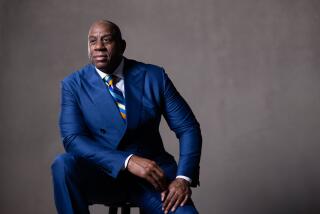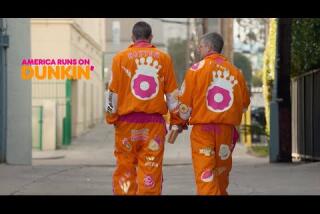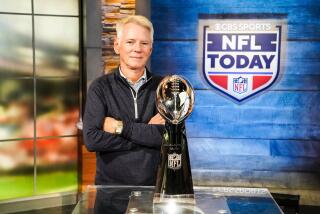The heady history of the slam dunk (and how street style stormed the NBA)

- Share via
Book Review
Magic in the Air: The Myth, the Mystery and the Soul of the Slam Dunk
By Mike Sielski
St. Martin’s Press: 368 pages, $32
If you buy books linked on our site, The Times may earn a commission from Bookshop.org, whose fees support independent bookstores.
Chances are you’ve heard of Julius Erving and Kareem Abdul-Jabbar. You would have to be culturally illiterate to be unfamiliar with Michael Jordan. But I’d bet money that you don’t know the story of Jack Inglis, who shares space with the legends in Mike Sielski’s new book “Magic in the Air.”

Inglis played pro basketball in the World War I era in the New York State League and Pennsylvania State League. This was when basketball courts were wrapped in wire fencing, or cages (hence the use of the word “cagers” to describe basketball players). Inglis, a superb athlete for his day, was known to climb up the fence alongside the basket, grab a pass with one hand, and drop it into the hoop from above. It was, as Sielski writes, “an early version of the slam dunk.”
This is the kind of hoops history you didn’t know you craved, and which Sielski’s fast break of a dunk study delivers in abundance. But “Magic” does more than provide juicy tidbits. In lacing up a lively history of the slam dunk, Sielski, a sports columnist for the Philadelphia Inquirer who writes with his profession’s characteristic flavor and flair, digs into the social and racial implications of sports’ most exciting play. He uses the stories of key athletes and moments to paint a bigger picture of a sport’s evolution from earthbound (and rather slow) competition to sky-high (and very fast) exuberance. “Magic in the Air” honors the dunk as a great feat of American improvisation, probably not as significant as jazz but not entirely dissimilar.

Like most revolutionary developments, the rise of the dunk struck fear in the establishment’s heart. The NCAA even banned the dunk from 1967 to 1976, which, when you think about it, is remarkably stupid: Hey, let’s eliminate the most kinetic part of the game, the play that makes fans stand and cheer like no other. As Sielski writes, “The rule seemed first and foremost a way to squelch the individual expression and athleticism that characterized the sport throughout urban America and that was intrinsic to the manner in which Black athletes played it.”
In short, the dunk was just too street. The ban was loudly championed by legendary Kentucky coach Adolph Rupp, whose all-white squad had just been spanked in the finals by a Texas Western (now University of Texas at El Paso) team that made history by starting five Black players. “It wasn’t just that players were dunking,” Sielski writes. “It was that Black players were dunking. And they were dunking while they were beating his team.” (Ironically, the best player on that Kentucky team, Pat Riley, would go on to preside over the dunk-happy Showtime Lakers teams of the ’80s).
There are many approaches one could take toward writing such a book. A stats and analytics obsessive, like Henry Abbott, might unfurl a study of leaping launch points and game situations in which the dunk makes the most sense. A run-of-the-mill aggregator could produce a glorified, book-length blog post ranking the best dunks and dunkers. Sielski chooses to apply a refreshingly human, old-school touch; “Magic in the Air” reads like a series of deeply reported, interconnected feature stories, rich in history and authorial voice.
When Sielski writes about the saga of Earl “The Goat” Manigault, a 6-foot-1 New York playground legend who soared among the giants but couldn’t stay away from heroin and other lures of the streets, he’s also writing about why Manigault’s story is catnip to (usually white) journalists looking for a certain kind of story — a story Manigault was always happy to tell. “Go ahead,” Sielski writes. “Pull up a chair or knock on his door, if you could pin down where he lived. He would tell you all about it, be genuinely wistful about his missed opportunities, open up and give you the goods. No athlete was in the passenger’s seat for more reporter ride-alongs than The Goat.”
There are, of course, bigger names here as well. They include Jordan, whose style, hang time and acrobatic dunking were as popular in corporate boardrooms as they were on playgrounds; Bill Russell and Wilt Chamberlain, who shook up the game with their athleticism and size in the ’50s and ’60s; and David “Skywalker” Thompson, who, at 6-foot-4, dominated college basketball while starring for North Carolina State but had to settle for gently laying the ball in due to the dunk ban. (Did we mention how stupid the dunk ban was?)
This has quietly been a great era for basketball books, including Rich Cohen’s “When the Game Was War,” Chris Herring’s “Blood in the Garden,” Jeff Pearlman’s “Showtime” (about those Riley Laker teams), and Hanif Abdurraqib’s “There’s Always This Year.” “Magic in the Air” belongs on the top shelf with those. For a study of life above the rim, its tone is down-to-earth and also briskly colloquial and infused with infectious passion for the sport.
Chris Vognar is a freelance culture writer.
More to Read
A cure for the common opinion
Get thought-provoking perspectives with our weekly newsletter.
You may occasionally receive promotional content from the Los Angeles Times.










